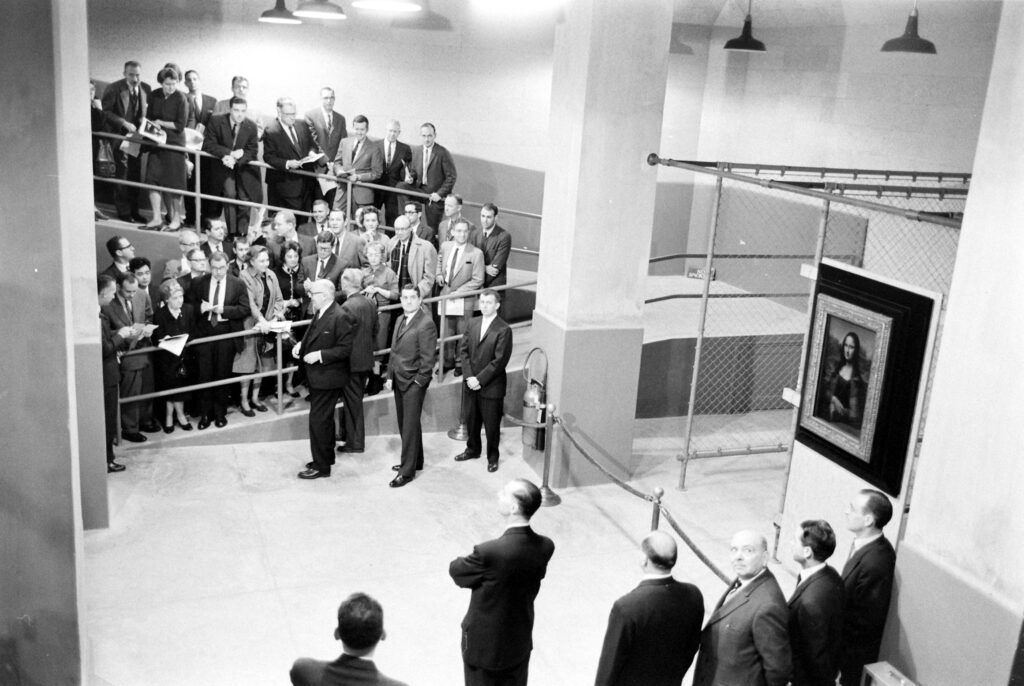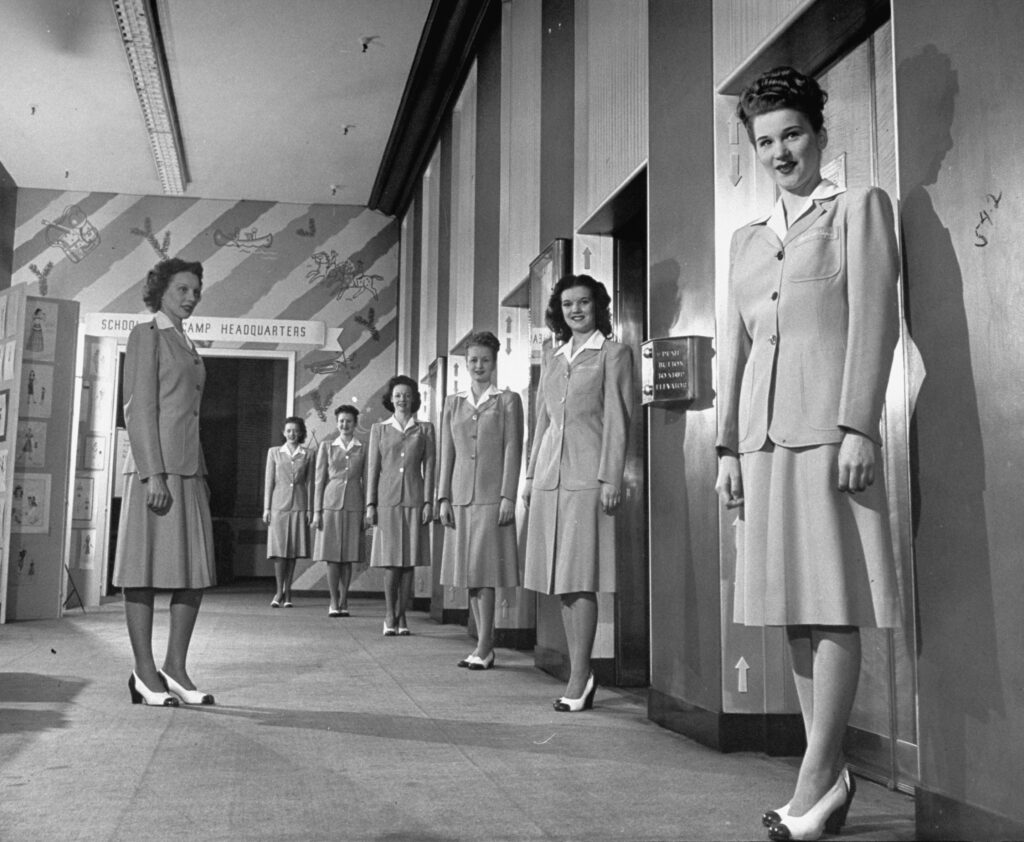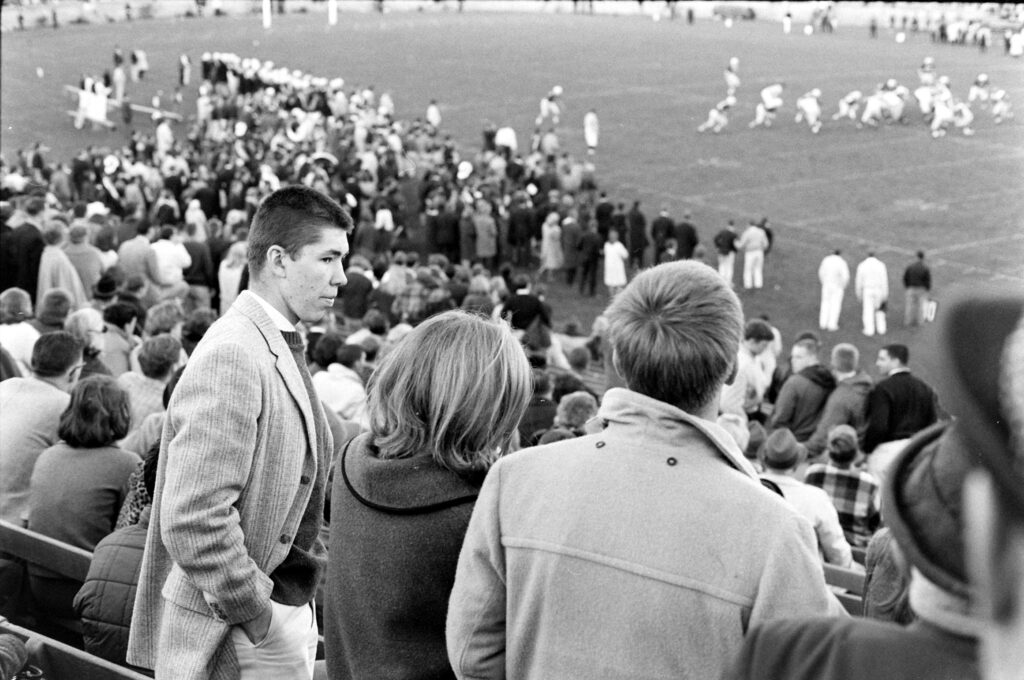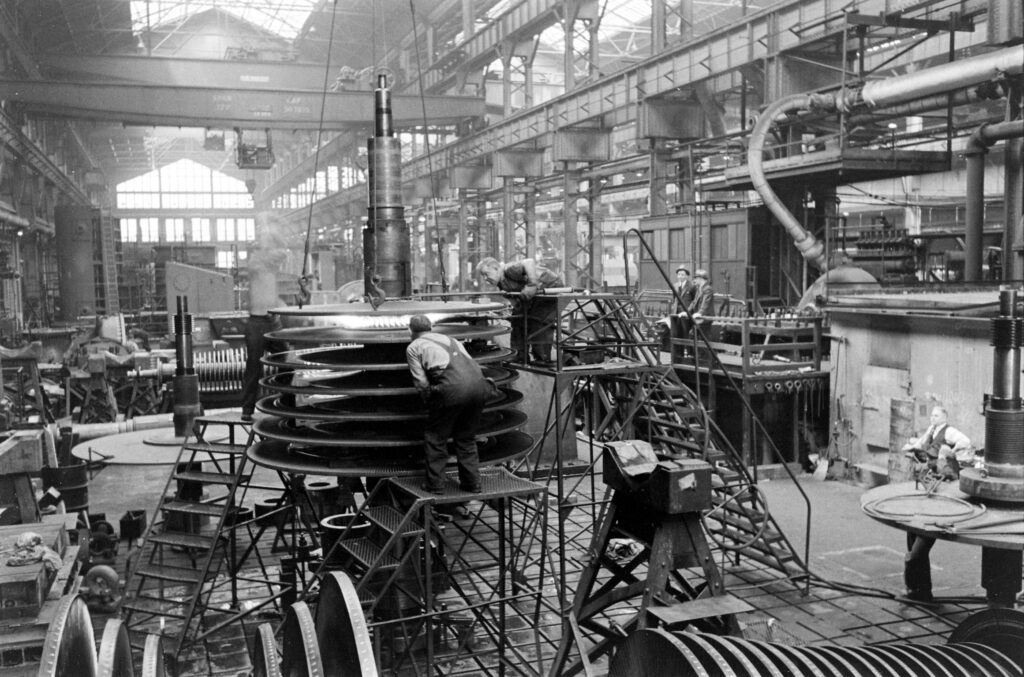Written By: Erin Livingston
The 2020 Republican National Convention has become a virtual event due to the COVID-19 pandemic, just as the Democratic Convention had the week before. Here LIFE dips into its archives for a colorful look at what the GOP event was like when people could safely convene.
LIFE’s first major coverage of a Republican National Convention was in its issue of June 24, 1940. At that gathering in Philadelphia, the Republicans nominated Wendell Willkie for the tough and ultimately futile task of challenging the popular Franklin D. Roosevelt in the general election.

The Philadelphia Convention Hall teemed during the 1940 Republican National Convention.
(William C. Shrout/The LIFE Picture Collection © Meredith Corporation)
Later years of LIFE’s coverage featured color photography that presented the delegates, their costumes and the spectacle in all their exuberance.

A crowd posed with a baby elephant during the 1956 Republican National Convention in San Francisco.
Leonard McCombe/The LIFE Picture Collection © Meredith Corporation.

The Cow Palace outside San Francisco hosted the 1956 Republican National Convention.
Ralph Crane/The LIFE Picture Collection © Meredith Corporation

Vice President Richard Nixon made his way through a crowd of supporters during the 1956 Republican National Convention.
(Ralph Crane/The LIFE Picture Collection © Meredith Corporation)

President Dwight D. Eisenhower and Vice President Richard Nixon at the 1956 Republican National Convention in San Francisco, where they accepted their party’s re-nomination.
Nat Farbman/The LIFE Picture Collection © Meredith Corporation
The 1956 Republican National Convention, which took place at the Cow Palace just outside San Francisco, re-nominated incumbent President Dwight D. Eisenhower and Vice President Richard Nixon. It was the first RNC to take place after that year’s Democratic National Convention, rather than before. After 1956, it became an informal tradition that the party holding the White House held their convention second.

Vice President Richard Nixon with his wife, Pat Nixon, at the 1956 Republican National Convention.
Ralph Crane/The LIFE Picture Collection © Meredith Corporation

An Eisenhower “Bandwagon” at the 1956 Republican National Convention.
Nat Farbman/The LIFE Picture Collection © Meredith Corporation

Vice President Richard Nixon waved to crowds at the 1956 Republican National Convention.
Leonard McCombe/The LIFE Picture Collection © Meredith Corporation

A ‘welcome’ motorcade passed through San Francisco’s Chinatown for the 1956 Republican National Convention.
Ralph Crane/The LIFE Picture Collection © Meredith Corporation

Women shook their pom-poms at the 1956 Republican National Convention.
Leonard McCombe/The LIFE Picture Collection © Meredith Corporation
Many of the color photographs taken during the 1956 RNC were shot by LIFE staff photographer Leonard McCombe. His beautiful frames imparted elegance to the sometimes-gimmicky qualities of a party convention.

LIFE photographer Leonard McCombe looked for captivating images at the 1956 Republican Convention in San Francisco.
Hank Walker/The LIFE Picture Collection © Meredith Corporation

This boy’s suit was festooned with campaign buttons at the 1956 Republican National Convention.
Leonard McCombe/The LIFE Picture Collection © Meredith Corporation

This woman’s “I Like Ike” sunglasses honored the star of the 1956 Republican National Convention in San Francisco.
Photo by Leonard McCombe/The LIFE Picture Collection © Meredith Corporation

These ‘Ike’ dresses honored President Dwight Eisenhower at the 1956 Republican National Convention.
Leonard McCombe/The LIFE Picture Collection © Meredith Corporation

Women waved red pom-poms at the 1956 Republican National Convention.
Leonard McCombe/The LIFE Picture Collection © Meredith Corporation

A delegate at the 1956 Republican National Convention in San Francisco.
Ralph Crane/The LIFE Picture Collection © Meredith Corporation

These ladies supported President Dwight D. Eisenhower at the 1956 Republican National Convention.
Ed Clark/The LIFE Picture Collection © Meredith Corporation

This elephant let you know whose party it was at the 1956 Republican National Convention in San Francisco.
Leonard McCombe/The LIFE Picture Collection © Meredith Corporation
Eisenhower and Nixon went on to win the 1956 election, easily defeating Adlai Stevenson. Four years later Vice President Nixon stepped up to lead the Republican ticket, and he had no opponents for the 1960 nomination.

The LIFE cover from August 8, 1960, featured Richard and Pat Nixon at the Republican National Convention in Chicago.
Stan Wayman/The LIFE Picture Collection © Meredith Corporation
The 1960 Republican National Convention in Chicago nominated Richard Nixon for president and former Senator Henry Cabot Lodge of Massachusetts for vice president. It was the 14th time Chicago hosted the RNC, more times than any other city.

Presidential nominee Richard Nixon greeted a supporter at the 1960 Republican National Convention.
Stan Wayman/The LIFE Picture Collection © Meredith Corporation

Outgoing President Dwight Eisenhower (with his wife Mamie) delivered a speech during the 1960 Republican National Convention.
Stan Wayman/The LIFE Picture Collection © Meredith Corporation
During the convention Nixon promised in his acceptance speech that he would visit every state during his campaign.
“I announce to you tonight, and I pledge to you, that I, personally, will carry this campaign into every one of the fifty states of this Nation between now and November the eighth.”

These Nixon supporters wore matching dresses for the 1960 Republican National Convention in Chicago.
Stan Wayman/The LIFE Picture Collection © Meredith Corporation
The 1960 presidential election was closely contested, and Nixon lost to the Democratic nominee, Senator John F. Kennedy. Some believed that Nixon’s convention promise of visiting every state—while Kennedy focussed on popular swing states—was one of the reasons that Nixon lost.

The July 24, 1964 cover of LIFE featuring Barry Goldwater with his wife Peggy at the 1964 Republican National Convention.
Bill Ray/The LIFE Picture Collection © Meredith Corporation
The 1964 Republican National Convention was held in the same location as the 1956 RNC, the Cow Palace Arena outside San Francisco. The Republican primaries pitted liberal Nelson Rockefeller of New York against Conservative Barry Goldwater of Arizona. Goldwater secured the nomination for president, and New York representative William Miller received the nomination for vice president.
Goldwater’s winning of the nomination meant a change for the party, as described by LIFE in its July 24th, 1964 issue, with Goldwater on the cover:
In a crescendo that thrust Barry Goldwater into control, the Republican changed both its course and its nature. In flashes of anger and pathos, of bitterness and exultation – captured on these pages by the color cameras of LIFE photographers – the G.O.P. was seized by its unyielding right wing.

Gold coins rained down on delegates after Goldwater won the presidential nomination at the 1964 Republican National Convention at the Cow Palace in San Francisco.
John Dominis/The LIFE Picture Collection © Meredith Corporation

Barry Goldwater and his wife Peggy received the presidential nomination during the 1964 Republican National Convention.
(John Dominis/The LIFE Picture Collection © Meredith Corporation)

The Cow Palace Arena hosted the 1964 Republican National Convention.
Ralph Crane/The LIFE Picture Collection © Meredith Corporation
The 1964 gathering was the first in which a woman was entered for nomination at a major party convention. Maine Senator Margaret Chase Smith, a moderate Republican, placed fifth in the initial balloting.

Delegates at the 1964 Republican National Convention held signs supporting the candidacy of Senator Margaret Chase Smith for president; she placed fifth on the first ballot.
John Dominis/The LIFE Picture Collection © Meredith Corporation

The ‘Goldwater Girls’ waved signs during the 1964 Republican National Convention.
John Dominis/The LIFE Picture Collection © Meredith Corporation

This hat recognized the Arizona roots of nominee Barry Goldwater.
John Dominis/The LIFE Picture Collection © Meredith Corporation

Barry Goldwater and his wife waved to attendees at the 1964 Republican National Convention.
John Dominis/The LIFE Picture Collection © Meredith Corporation

Delegates and balloons filled the Cow Palace during the 1964 Republican National Convention.
(Photo Ralph Crane/The LIFE Picture Collection © Meredith Corporation)
Goldwater was an outspoken conservative and an opponent of the 1964 Civil Rights Act. Goldwater’s candidacy fueled several days of protests outside the 1964 RNC.

Marchers dressed as KKK members to condemn Barry Goldwater outside the 1964 Republican National Convention.
John Dominis/The LIFE Picture Collection © Meredith Corporation

The March for Equality took place outside the 1964 Republican National Convention.
John Dominis/The LIFE Picture Collection © Meredith Corporation

The March for Equality protested Barry Goldwater’s nomination outside the 1964 Republican National Convention.
John Dominis/The LIFE Picture Collection © Meredith Corporation
Goldwater lost the general election to incumbent President Lyndon B. Johnson in a landslide, but his nomination contributed to the Republican party’s modern conservative movement.

Presidential nominee Richard Nixon (right) and Vice Presidential nominee Spiro Agnew shared the podium during the Republican National Convention in Miami Beach.
Mark Kauffman/The LIFE Picture Collection © Meredith Corporation

The LIFE cover from August 16, 1968, featured nominees Richard Nixon and Spiro Agnew after their convention win.
Arthur Schatz/The LIFE Picture Collection © Meredith Corporation
The 1968 Republican National Convention took place in the Miami Beach convention center in Florida. As they had eight years before, Republicans nominated former Vice President Richard Nixon for president, and Maryland Governor Spiro Agnew was chosen for vice president.

An enthusiastic crowd greeted Richard Nixon standing at the 1968 Republican National Convention, Miami Beach, Florida.
Ralph Crane/The LIFE Picture Collection © Meredith Corporation

The release of balloons celebrated the nomination of Richard Nixon and Spiro Agnew, who took in the scene from the podium at the 1968 Republican Convention.
Photo by Ralph Crane/The LIFE Picture Collection © Meredith Corporation
Though Nixon was the frontrunner during the convention, California Governor Ronald Reagan and New York Governor Nelson Rockefeller also received several hundred votes. LIFE’s coverage of the Miami Beach RNC was the most colorful yet. An article written by Paul O’Neil in the August 16, 1968 issue of LIFE details go-go music, ‘gaudy’ headgear, costumes, and even a Rockefeller showboat that moved up and down a river by the convention’s hotels.

A Rockefeller supporter on a showboat waved to a Nixon boat during the 1968 Republican National Convention, Miami Beach, Florida.
Lynn Pelham/The LIFE Picture Collection © Meredith Corporation

Governor Nelson Rockefeller signed autographs for supporters at the 1968 Republican National Convention, Miami Beach, Florida.
Lynn Pelham/The LIFE Picture Collection © Meredith Corporation

California Governor Ronald Reagan was a rising star at the 1968 Republican National Convention, Miami Beach, Florida.
Lynn Pelham/The LIFE Picture Collection © Meredith Corporation

This supporter of Nelson Rockefeller made sure to get noticed at the 1968 Republican National Convention, Miami Beach, Florida.
Photo by Ralph Crane/The LIFE Picture Collection © Meredith Corporation

Despite enthusiastic fans, “Rocky” didn’t pull off the upset at the 1968 Republican National Convention, Miami Beach, Florida.
Photo by Ralph Crane/The LIFE Picture Collection © Meredith Corporation

Uncle Sam stood tall on stilts during the 1968 Republican National Convention, Miami, Florida.
Ralph Crane/The LIFE Picture Collection © Meredith Corporation

Republicans worked on their platform at the 1968 Republican National Convention, Miami Beach, Florida.
Photo by Ralph Crane/The LIFE Picture Collection © Meredith Corporation

These glasses featured a popular Nixon slogan at the 1968 Republican National Convention.
Lynn Pelham/The LIFE Picture Collection © Meredith Corporation

Leftover signs and trash in Miami Beach Convention Hall from the 1968 Republican National Convention.
Mark Kauffman/The LIFE Picture Collection © Meredith Corporation)

A friendly elephant carried the GOP message at the 1968 Republican National Convention, Miami Beach, Florida.
Ralph Crane/The LIFE Picture Collection © Meredith Corporation

A worker prepared a barrage of balloons at the 1968 Republican National Convention in Miami Beach, Florida.
Ralph Crane/The LIFE Picture Collection © Meredith Corporation

Supporters of Ronald Reagan, who would win the presidency in 1980, at the 1968 Republican National Convention.
Ralph Crane/The LIFE Picture © Meredith Corporation

This elephant gained elevation during the 1968 Republican National Convention.
Ralph Crane/The LIFE Picture Collection © Meredith Corporation

The Miami Beach convention hall hosted the 1968 Republican National Convention.
Grey Villet/The LIFE Picture Collection © Meredith Corporation

Ladies wore woven floral and grass hats at the 1968 Republican National Convention, Miami Beach, Florida.
Ralph Crane/The LIFE Picture Collection © Meredith Corporation

Delegates at the 1968 Republican National Convention cheered for nominee Richard Nixon, Miami Beach, Florida.
Ralph Crane/The LIFE Picture Collection © Meredith Corporation
Nixon defeated Democratic nominee, Herbert Humphrey, in the the 1968 presidential election. The election year was chaotic, marked by the assassination of Martin Luther King Jr., the assassination of Robert F. Kennedy, and widespread opposition to the Vietnam war. Nixon ran on a platform to “restore law and order.”

President Richard Nixon accepted a renomination at the 1972 Republican National Convention, Miami Beach, Florida.
Bill Eppridge/The LIFE Picture Collection © Meredith Corporation
The 1972 Republican National Convention was supposed to take place in San Diego, but because of labor costs and scandals, the GOP changed course three months beforehand and decided to return to Miami Beach to re-nominate Richard Nixon for president.
The 1972 RNC set a new standard for party conventions, as it was a scripted media event with a schedule of speeches, setting the stage for the modern party convention.

First Lady Patricia Nixon spoke at the 1972 Republican National Convention, Miami Beach, Florida.
Bill Eppridge/The LIFE Picture Collection © Meredith Corporation

Supporters outside the 1972 Republican National Convention, Miami Beach, Florida.
Bill Eppridge/The LIFE Picture Collection © Meredith Corporation

Richard Nixon’s daughters and their spouses— from left to right, Edward Cox, Tricia Nixon Cox, Julie Nixon Eisenhower and David Eisenhower—joined the party at the 1972 Republican National Convention.
Bill Eppridge/The LIFE Picture Collection © Meredith Corporation


































































